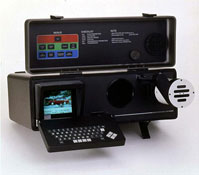How sports photographers transmitted Olympic photos in the days before digital cameras
posted Monday, July 23, 2012 at 5:18 PM EDT
 With the Summer Olympics in London coming up in just a few days, thousands of digital images of atheletes will be flying wirelessly around the globe every few minutes. Ever wonder how wire service sports photographers got their images out to editors in the days of film?
With the Summer Olympics in London coming up in just a few days, thousands of digital images of atheletes will be flying wirelessly around the globe every few minutes. Ever wonder how wire service sports photographers got their images out to editors in the days of film?
Take a look at the device on the right. It's called a Dixel CM, and it's the last of the original film scanner/transmitters that helped spark the digital imaging revolution.
The company that made it was Hasselblad, the Swedish camera manufacturer better known for its high-end medium format models. The Dixel was created by Hasselblad for Agence France Presses (AFP) -- a competitor to the Associated Press -- who first used it at the Calgary Winter Olympic Games in 1988.
Chris Wilkins, currently Deputy Director of Photography at The Dallas Morning News, remembers what it was like to use a Dixel when he worked for AFP as a staff photographer back in the 1980s.
"The Dixel gave AFP a serious competitive advantage over the other wire services," Wilkins writes in The Dallas Morning News' Photography Blog.
"Transmitting a color photo took around two or three minutes, and the quality and sharpness was unprecedented. AFP staff photographers were relieved and looked forward to leaving bulky printmaking equipment and analog transmitters behind."
On the downside, The Dixel was a nightmare for photographers to travel with.
"The fragile machine was fine in an office setting but was often damaged in transit, loosening internal computer boards and the optical scanning unit. The relatively small computer had to be shipped in a huge travel case, encased in a 12-inch thick foam lining," Wilkins recalls.
"AFP photographers became amateur computer technicians in the field, tearing the machines down and trying to coax them back into service. The Dixel became so undependable that we soon reverted to carrying the old printing equipment as a backup just in case it didn’t work. Add another huge case to the load."
Click here to read more of Wilkins' thoughts on the "good old days" of film when, he says, photographers often resembled "pack mules," because of all the darkroom equipment, enlargers and manual typewriters -- for writing captions -- they had to carry around.
For instance, this picture of a clunky, early black-and-white drum print transmitter hooked up to a vintage rotary phone makes me want to hug my memory card reader tightly to my chest.